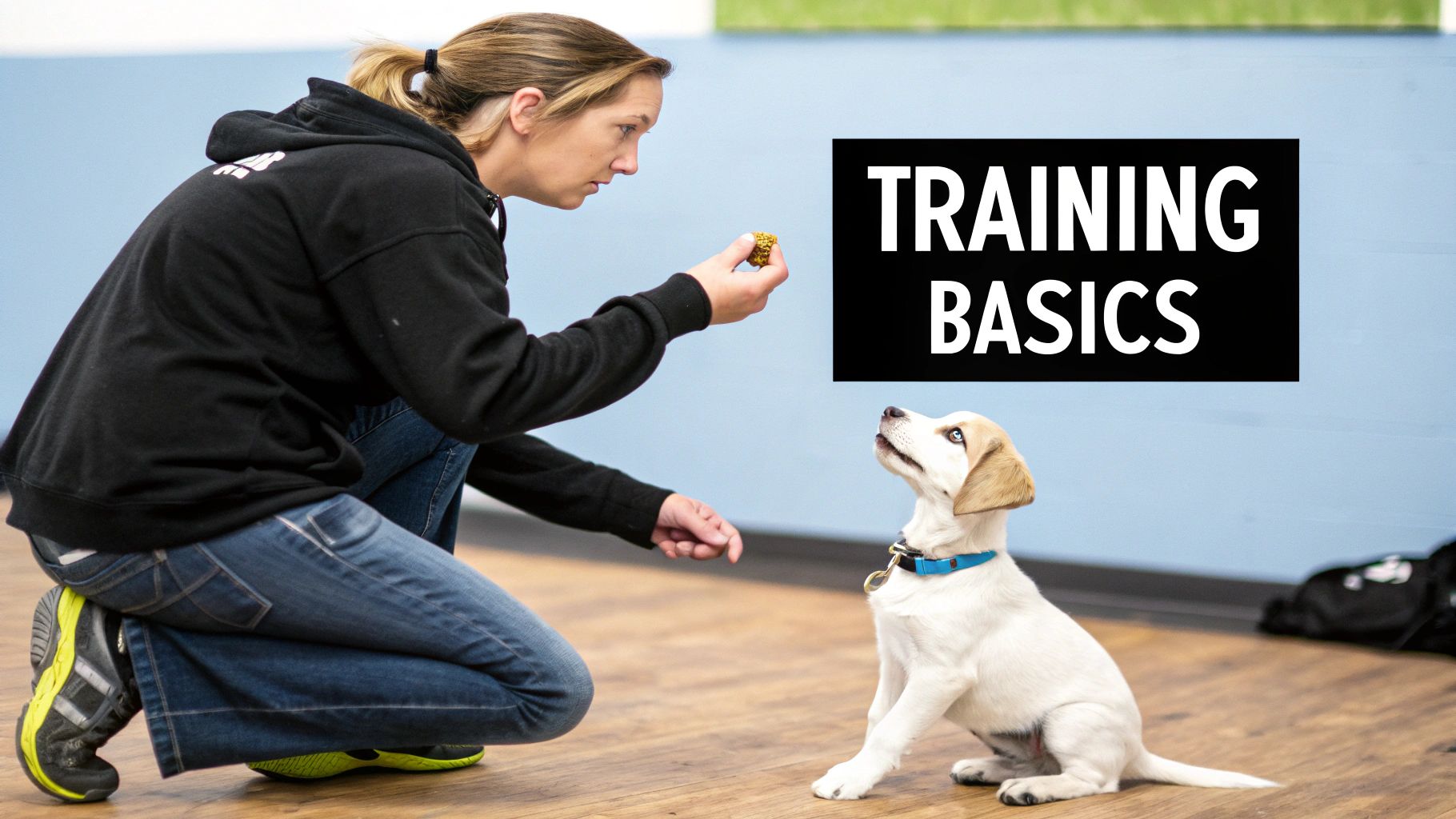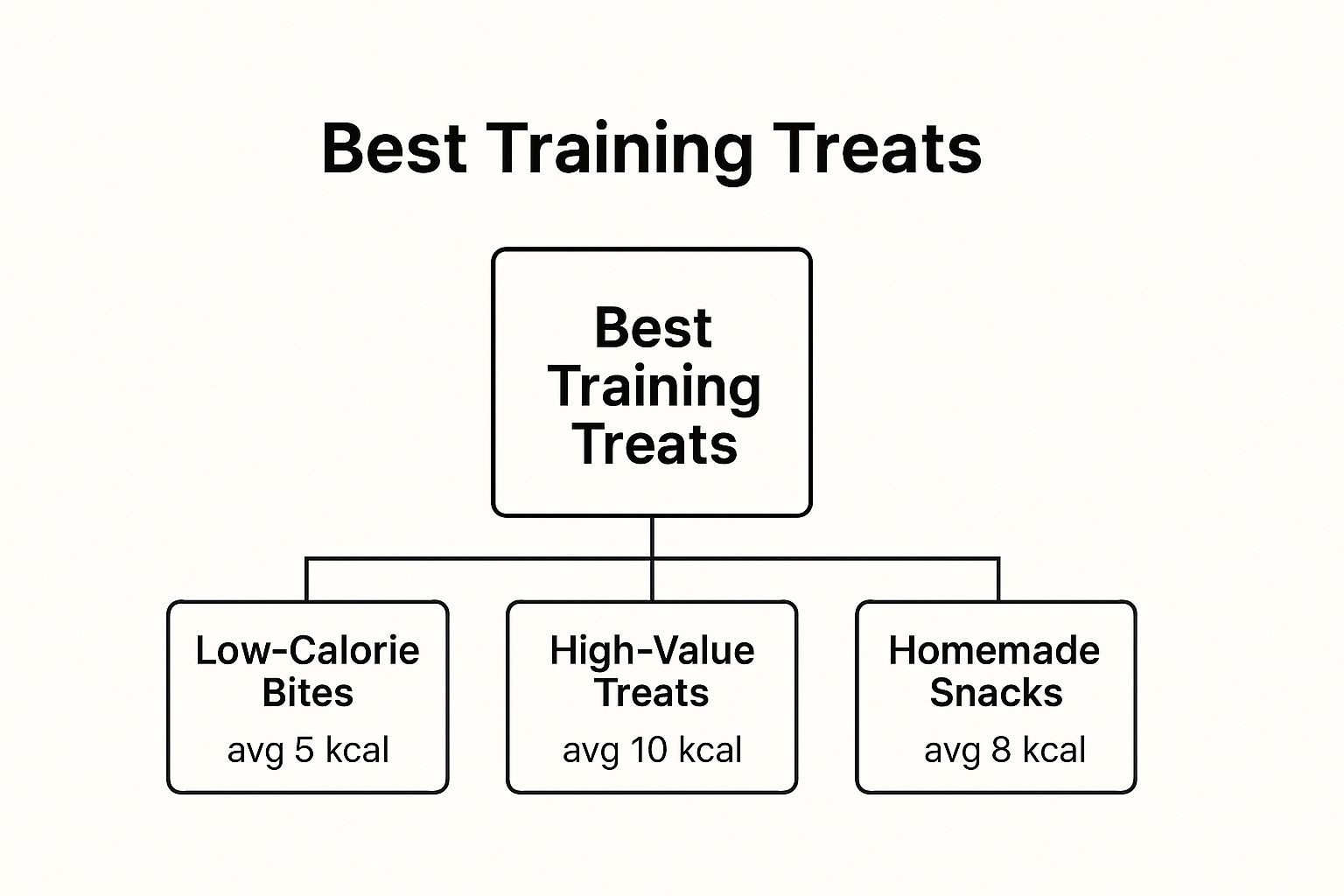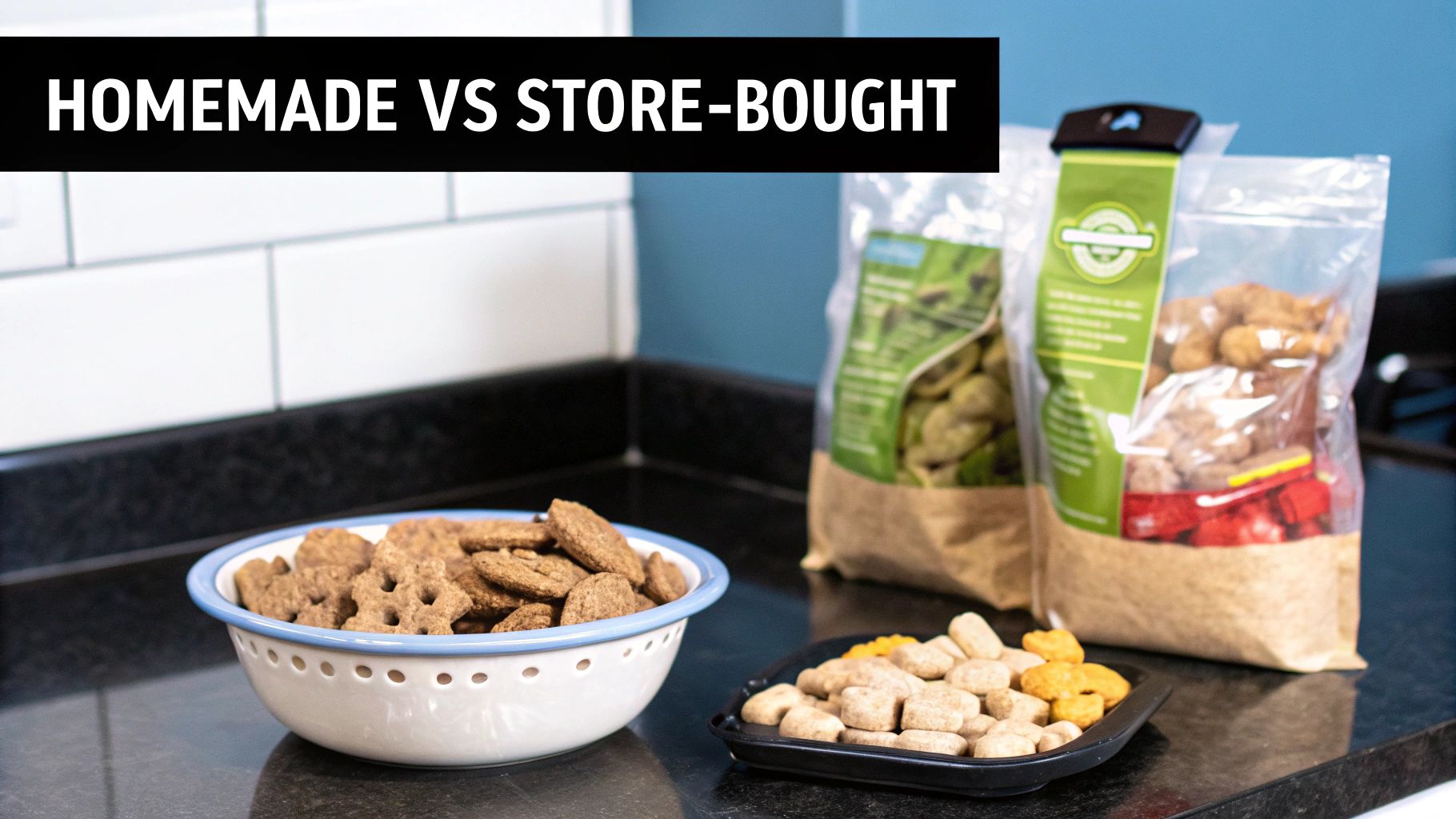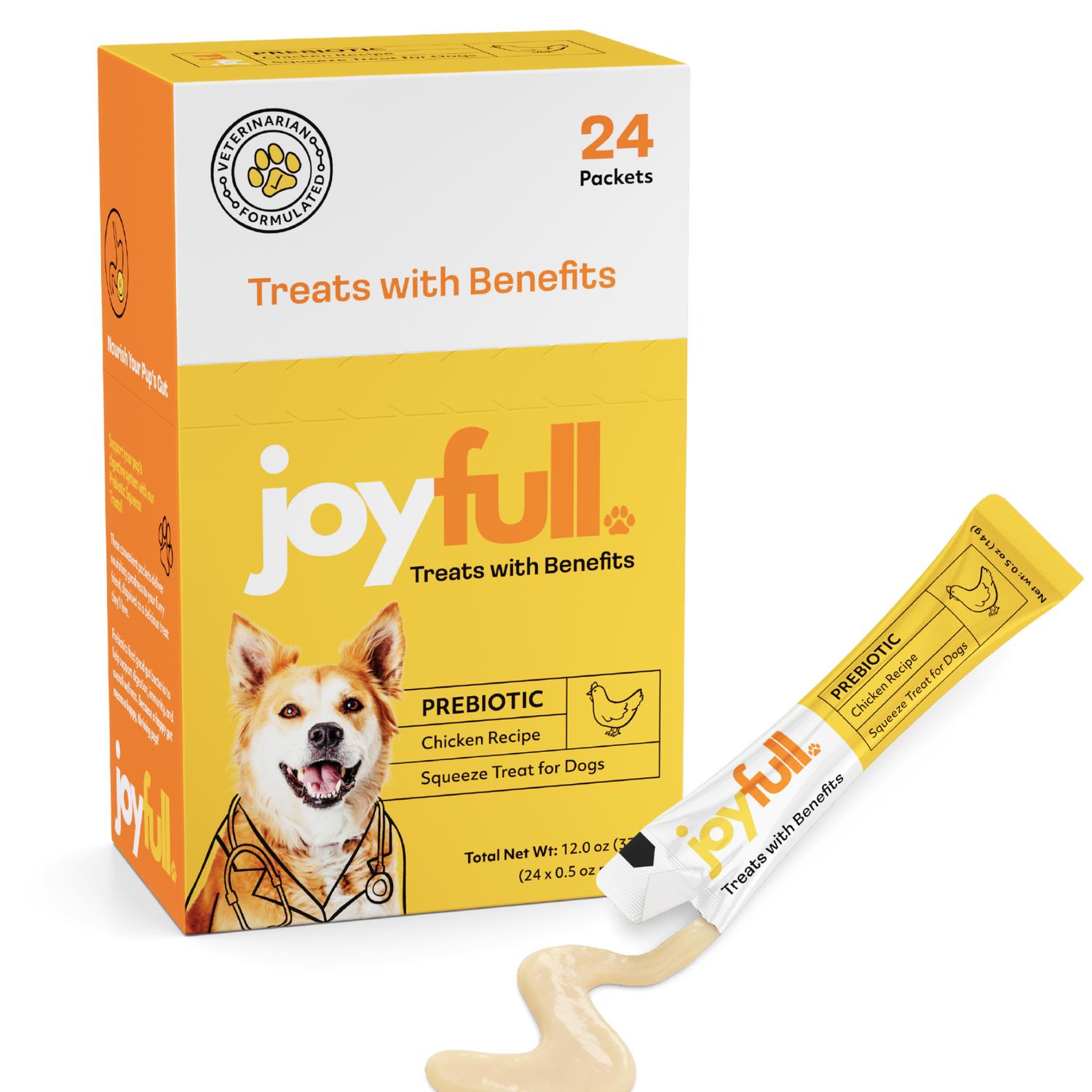
Top 10 Best Training Treats for Dogs | Healthy & Effective Rewards
When it comes to training treats, think small, soft, smelly, and low-calorie. These four qualities are the secret sauce for frequent, high-impact rewards that won’t pack on the pounds. Things like freeze-dried liver, soft-baked bites, or even tiny pieces of plain cooked chicken work wonders because they're incredibly motivating and grab a dog's attention instantly.
Why the Right Treat Transforms Dog Training

Choosing a training treat isn’t just about giving your dog a snack for a job well done. It’s about arming yourself with a powerful communication tool. The best training treats act as a high-value currency that keeps your dog laser-focused, engaged, and genuinely excited to learn, even when the world around them is full of distractions.
Think of it this way: you might do a small favor for a simple "thank you," but you'd go the extra mile for a nice bonus. For your dog, a piece of their regular kibble is that polite thank you. A small, aromatic, and delicious treat? That's the bonus that makes them eager to put in the effort.
Capturing Focus and Accelerating Learning
A truly high-value reward is your secret weapon for cutting through the noise. Imagine you're at a busy park trying to teach a critical command like "come." A boring old biscuit has zero chance of competing with other dogs, new smells, and all the exciting chaos.
A treat that genuinely motivates your dog makes you more interesting than any of those distractions. It forges a direct line of communication, turning a potentially frustrating session into a fun, productive partnership.
This focused attention means your dog learns commands faster and remembers them longer. Every time they succeed and get that fantastic reward, it reinforces the behavior and builds a strong positive association. This process does more than just teach cues; it deepens the bond you share, building a foundation of trust and cooperation.
The Growing Market for Better Treats
This focus on effective rewards is mirrored in the booming pet treat market. As more of us see our pets as true family members, the demand for specialized, high-quality training aids has skyrocketed. We're constantly seeing new innovations, from functional treats that also boost health to creative tools that make rewarding easier.
For example, the market for products like dog treat launchers is on track to hit USD 332.4 million in 2025. This number really highlights how much pet owners are investing in effective training. It points to a bigger trend: we're moving towards products that don't just reward but actively improve the training experience and our dogs' overall well-being. You can read more about the growth in pet training products and see just how the market is changing.
How to Read a Dog Treat Label Like a Pro
Ever feel lost in the pet food aisle? Trying to find the best training treats for your dog can be genuinely overwhelming. Deciphering an ingredient label shouldn't require a Ph.D., but a little know-how can make all the difference between picking up a truly healthy reward and grabbing some cleverly marketed junk.
Think of an ingredient list like a team’s starting lineup. The players listed first are the ones getting the most time on the field. In this case, the ingredients at the top of the list make up the bulk of the treat. Your goal is to make sure the star players are high-quality proteins, not cheap fillers.
The First Ingredient Rule
The single most important thing to look at is the first ingredient. If you see a whole protein source right at the top—like "chicken," "beef," "salmon," or "duck"—you’re off to a great start. This tells you the treat is built around real, high-quality animal protein, which is exactly what your dog needs for fuel and focus.
Watch out for vague terms, though. Things like "meat by-products" or "poultry meal" are a world away from "whole chicken." These are often lower-quality ingredients that can include the less desirable, less nutritious parts of an animal.
Your Quick Health Checklist:
- First Ingredient: Is it a specific, named meat (e.g., "duck" not just "meat")?
- Fillers: Are corn, wheat, or soy high on the list? These often just add empty calories.
- Preservatives: Does it use natural options like tocopherols (a form of vitamin E) or artificial ones like BHA or BHT?
Always try to find treats where recognizable, whole-food ingredients lead the pack. It’s the clearest sign that the manufacturer, like us at Joyfull, cares more about quality nutrition than cutting costs.
Decoding Common Label Terms
The language on dog treat packaging can be tricky. Some phrases are designed to sound healthy but might not mean what you think. Getting a handle on these terms helps you make a truly informed choice for your four-legged friend.
-
Single-Ingredient: This is the gold standard for simplicity and a lifesaver for dogs with allergies. A single-ingredient treat, like a freeze-dried liver bite, contains only that one item. No fillers, no preservatives, no funny business.
-
Grain-Free: This one’s pretty straightforward—it just means the treat doesn't have grains like wheat, corn, or rice. While that's great for dogs with grain sensitivities, "grain-free" doesn't automatically equal "healthy." Some brands just swap grains for other starches like potato or pea flour, which can still be low-quality fillers.
-
Human-Grade: This term means the ingredients are legally fit for people to eat. It's a fantastic sign of quality control and ingredient safety. It assures you that your dog is getting treats made with the same high standards you’d expect for your own food.
Avoiding Hidden Troublemakers
Finally, keep an eye out for the stuff that can actively sabotage your training sessions. I'm talking about artificial colors (like Red 40 or Yellow 5), artificial flavors, and chemical preservatives (like BHA, BHT, and ethoxyquin). These have been linked to everything from digestive upset to allergic reactions in some dogs.
A dog with an upset stomach is a dog that can't focus on learning. By choosing treats with a clean, simple ingredient panel, you aren’t just giving a reward; you’re fueling your dog's body and mind for success. That’s why sticking to natural, recognizable ingredients is one of the best things you can do for your training partner.
What Makes a Training Treat Great?
When it comes to training your dog, not just any treat will do. The best ones are more than just a tasty morsel; they're powerful tools that can make or break your training session. Think of it like a chef picking the perfect spice for a signature dish—the right treat can elevate the entire experience.
A truly great training treat needs to do one job above all others: motivate. It has to be exciting enough to grab your dog’s full attention, keep them focused, and make them genuinely eager to work with you. When you get this part right, training stops feeling like a chore and becomes a fun, engaging game for both of you.
Size And Texture For Rapid Rewards
Have you ever tried to teach a new command while your dog is busy for a full minute, crunching away on a big, hard biscuit? It completely kills the momentum. The flow is gone, your dog’s focus is on the snack, and you’ve lost your training window. This is precisely why size and texture are so critical.
The gold standard for training treats is small and soft.
- Small Size: Think pea-sized. A treat this small delivers a quick, satisfying burst of flavor without a long chewing-and-swallowing break. This lets you reward your dog over and over again in a single session, keeping the pace up.
- Soft Texture: A soft or chewy treat is gone in a flash. This instant gratification keeps your dog’s eyes locked on you, waiting for the next cue, instead of on the floor trying to find crumbs.
This powerful combination ensures the reward enhances the training rhythm instead of disrupting it. It keeps the learning quick, focused, and free of distractions.
Low-Calorie Impact For Healthy Training
In a productive 15-minute training session, you might hand out dozens of treats. If those rewards are packed with calories, you could easily overfeed your dog, which can lead to unhealthy weight gain over time. This is where a low-calorie impact is non-negotiable.
An ideal training treat should be very low in calories—aim for under 5 calories per piece. This gives you the freedom to be generous with praise and rewards, reinforcing good behavior without a hint of guilt. High-frequency positive reinforcement is the secret to building strong, reliable skills, and low-calorie treats make it possible while keeping your dog lean and healthy.
Many owners also look for treats with a little something extra, like ingredients that support joint health. For more on that, you can find great information in our guide to choosing the best dog treats for arthritis.
A great rule of thumb is the 10% Rule. Treats should never account for more than 10% of your dog’s total daily calories. Sticking with low-calorie options makes it incredibly easy to stay within this healthy guideline.
High Palatability: The “Wow” Factor
Let’s be honest: in your dog’s world, a piece of kibble doesn’t hold a candle to a bite of chicken. That difference in appeal is what we call palatability. For a treat to be a true motivator, it needs to have a high "wow" factor. It has to be special enough to cut through distractions, whether you’re at the park or in a busy training class.
The table below can help you weigh your options when you're at the store.
Evaluating the Perfect Training Treat
This table breaks down the key features of an ideal training treat, helping you quickly evaluate different options.
| Characteristic | Why It Matters for Training | What to Look For |
|---|---|---|
| Small Size | Allows for rapid, repeated rewards without filling your dog up. | Pea-sized or smaller; easily breakable. |
| Soft Texture | Eaten quickly, which keeps your dog's focus on you and the task. | Chewy, moist, or freeze-dried textures. Avoid hard, crunchy biscuits. |
| Low Calories | Enables frequent rewards without causing weight gain. | Under 5 calories per treat is ideal. Check the packaging. |
| High Palatability | A high-value reward that keeps your dog motivated and engaged. | Real meat or fish as the first ingredient; strong, enticing aroma. |
By keeping these points in mind, you can find a treat that your dog absolutely loves and that helps you reach your training goals faster.

This image really highlights the trade-off we sometimes have to make. The most drool-worthy, high-value rewards often come with more calories. That’s perfectly fine! You just need to be strategic, saving those super-special treats for the biggest challenges, like recall training in a distracting place. The key is finding the right balance between what your dog goes crazy for and what’s healthy for them to enjoy every day.
The Rise of Human-Grade Ingredients in Dog Treats

Let's be honest, the way we think about our dogs has completely changed. They’re not just pets anymore. They’re the family member who hogs the bed, gets their own stocking at Christmas, and has a dedicated spot on the couch. This big shift in thinking, what some call pet humanization, is shaking up the dog treat industry in the best way possible.
As dog owners, we’ve started looking at our dogs' food with the same critical eye we use for our own. We're reading labels, questioning weird-sounding fillers, and demanding to know exactly what’s in their bowls. This has created a massive wave of demand for human-grade ingredients—foods that are legally safe and suitable for people to eat. It boils down to a pretty simple question: if it's not good enough for me, why would I give it to my dog?
This movement is fantastic news for you, because it means safer, healthier, and far more effective options when you're searching for the best training treats for dogs.
From Filler to Functional Fuel
For a long time, the dog treat aisle was filled with products packed with cheap fillers. Think corn, wheat, and vague "meat by-products." These ingredients didn't offer much in the way of nutrition and could sometimes even cause stomach issues, making it tough for a dog to focus during a training session. The human-grade trend has thankfully flipped that old model on its head.
Today's best treats are built from the ground up with ingredients you'd find in your own kitchen: high-quality proteins, whole fruits, and real vegetables. This isn't just clever marketing; it’s about providing real, tangible health benefits.
A treat made from human-grade ingredients isn't just a reward. It's a piece of clean, functional fuel that supports your dog’s overall health, which directly impacts their energy levels, focus, and ability to learn.
And this isn't some small, niche trend. The global market for pet snacks and treats hit an incredible USD 43.2 billion in 2025 and is expected to more than double, reaching USD 118.3 billion by 2034. That explosive growth is almost entirely driven by owners like us who are actively seeking out better, more nutritious options. You can read the full market forecast about pet treats to get a deeper look at how this is changing the industry.
The Emergence of Functional Treats
This push for better ingredients has also paved the way for something truly exciting: functional treats. These are rewards designed to do more than just taste good. They’re specifically crafted with health goals in mind, turning every training moment into a chance to boost your dog's well-being.
Now, you can find treats formulated to:
- Support joint health with ingredients like glucosamine and chondroitin.
- Promote dental hygiene with special textures that help clean teeth.
- Boost cognitive function with brain-healthy omega-3s like DHA.
- Calm anxiety using natural ingredients like chamomile or L-theanine.
Choosing treats with these kinds of benefits means every "good boy" or "good girl" is also a small step toward a longer, healthier life. This is the new standard we champion at Joyfull—because a healthy life isn't just for people. Our pets deserve it, too.
Tailoring the Reward to the Training Goal

When it comes to dog training, a one-size-fits-all approach to treats just doesn't cut it. Think about it this way: you wouldn't give a kid the same prize for tying their shoes as you would for winning the science fair. To make your training stick, the value of the reward needs to match the difficulty of the task.
This is where having a "treat toolkit" becomes a game-changer. Imagine a toolbox, but instead of wrenches and screwdrivers, it’s stocked with different levels of treats. This lets you pull out the perfect motivator for any situation, keeping your dog focused and making your training sessions way more effective.
Low-Value Treats for Everyday Practice
These are the bread and butter of your treat arsenal. Low-value rewards are perfect for reinforcing simple commands your dog already knows, especially when you're practicing in a quiet spot like your living room.
When you're running through a quick "sit" or "stay" with no distractions, you don't need to break out the filet mignon of treats. A simple, familiar reward will do the trick.
- What to Use: Your dog’s regular kibble or a small, plain biscuit works perfectly.
- Why it Works: These treats offer a little nod of approval without getting your dog overly hyped up. They’re just enough to say, "Yep, that's what I wanted."
Using kibble is also a smart way to manage your dog's daily calorie count, particularly if you're doing a lot of repetitions. It's the reliable foundation of your reward system.
High-Value Treats for Tougher Challenges
Now we’re talking about the big guns. High-value treats are the extra-special, super-tasty rewards you save for the most difficult training moments. They need to be smelly, delicious, and something your dog goes absolutely bonkers for.
Think of high-value treats as your secret weapon. You pull them out when you need to be more exciting than a squirrel, another dog, or that mystery scrap of food on the sidewalk.
You’ll want these on hand when you're teaching a rock-solid recall at a busy park or navigating those crucial first few potty training sessions with a new puppy.
- What to Use: Aromatic powerhouses like freeze-dried liver, tiny bits of cheese, shredded chicken, or smelly salmon treats are fantastic choices.
- Why it Works: The powerful smell and flavor slice through distractions, creating an incredibly strong positive connection to the new skill you're teaching.
Accounting for Special Needs
A truly effective treat toolkit is also adaptable. A senior dog with sensitive teeth won't appreciate a hard, crunchy biscuit, while a young puppy will need tiny, easy-to-swallow treats for frequent rewards during potty training.
For dogs with food sensitivities or allergies, single-ingredient or limited-ingredient treats are non-negotiable. If you're looking for a treat that's not only high-quality but also offers specific health advantages, exploring a specially formulated option like Joyfull treats with benefits can be the perfect solution.
By thoughtfully choosing the right treat for both the task and your dog's unique needs, you're setting yourself—and your pup—up for success.
Common Questions About Dog Training Treats
Even when you've done all your homework, a few questions can still pop up when you're in the thick of training. That's perfectly normal! Let's walk through some of the most common practical concerns people have about training treats. Think of this as your go-to guide for those little "what if?" moments that come up.
Getting the reward part right is a balancing act between good nutrition, high motivation, and keeping your dog safe. When you nail these details, your training sessions become more effective and strengthen the healthy, positive bond you share with your best friend.
How Many Treats Are Too Many in One Day?
The best rule of thumb to live by is the 10% rule. It’s simple: treats should never make up more than 10% of your dog's total daily calories. Following this guideline is the easiest way to prevent overfeeding and keep your dog at a healthy weight.
To make this work, especially during a heavy training day, use tiny, low-calorie rewards. You can break larger treats into pea-sized bits to make them go further. For those extra-long sessions, you can even mix some of your dog's regular kibble into your treat pouch. It's also a good idea to keep an eye on your dog's body condition and slightly reduce their main meals if you've had a particularly treat-heavy day.
Can I Use Human Food for Training?
Yes, you can, but you have to be incredibly careful. Certain human foods can be amazing high-value rewards, especially when you’re trying to teach a tough new skill or get your dog's attention in a distracting environment. A tiny, unseasoned piece of cooked chicken, a bit of carrot, or a green bean can be a game-changer for a picky pup.
The danger is that many common human foods are toxic to dogs. You must always avoid things like onions, garlic, grapes, raisins, chocolate, and anything with the artificial sweetener xylitol. Before you share any human food, double-check that it's safe for dogs. And remember, keep the portions small to avoid an upset stomach.
The key is moderation and safety. While human food can be a powerful tool, it should be an occasional jackpot, not a daily staple. When in doubt, it’s always safest to stick with a commercially prepared treat made specifically for dogs.
For a deeper dive into all sorts of questions, feel free to explore our Joyfull Pet FAQs page, where we cover a huge range of topics.
What If My Dog Has Allergies?
Choosing the right treat is absolutely critical if your dog has known food allergies or sensitivities. Your best bet here is to look for limited-ingredient diet (LID) or single-ingredient treats. These products make it super simple to avoid the specific proteins or grains that cause your dog trouble.
If you know your dog reacts to common proteins like chicken or beef, seek out treats made with novel proteins—ones your dog likely hasn't had before. Things like duck, venison, or fish are great options. Get in the habit of meticulously reading every ingredient label to make sure there are no hidden allergens. For dogs with severe allergies, your vet might even suggest specialized hydrolyzed protein treats, which are designed so the body doesn't recognize them as an allergen.
How Do I Motivate a Picky Dog?
When it comes to picky eaters, a powerful scent is your secret weapon. You need to figure out what your dog finds irresistible, and that often comes down to smell. It might take a little trial and error, but once you find what clicks, you're golden.
- Go for Strong Scents: Try treats with a pungent aroma, like freeze-dried salmon, liver, or even green tripe. The smellier, the better!
- Play with Textures: Some dogs are all about texture. They might go wild for a soft, chewy jerky-style treat over a crunchy biscuit any day.
- Make It Exclusive: This is a big one. Once you find their absolute favorite, reserve that treat only for training sessions.
When a reward is saved just for learning, its value goes through the roof. That exclusivity makes the treat far more exciting and motivating when it's time to work.
At Joyfull, we believe a healthy life isn't just for humans—our pets deserve it, too. That's why we craft our treats with clean, high-quality ingredients, ensuring every reward is as nutritious as it is delicious. Explore our full range of beneficial treats today.

